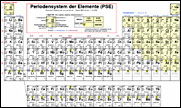Krypton
1
2
3
4
5
6
7
8
9
10
11
12
13
14
15
16
17
18
19
20
21
22
23
24
25
26
27
28
29
30
31
32
33
34
35
36
37
38
39
40
41
42
43
44
45
46
47
48
49
50
51
52
53
54
55
56
57
58
59
60
61
62
63
64
65
66
67
68
69
70
71
72
73
74
75
76
77
78
79
80
81
82
83
84
85
86
87
88
89
90
91
92
93
94
95
96
97
98
99
100
101
102
103
104
105
106
107
108
109
110
111
112
113
114
115
116
117
118
Actinium
Aluminium
Americium
Antimon
Argon
Arsen
Astat
Barium
Berkelium
Beryllium
Bismut
Blei
Bohrium
Bor
Brom
Cadmium
Caesium
Calcium
Californium
Cer
Chlor
Chrom
Cobalt
Copernicium
Curium
Darmstadtium
Dubnium
Dysprosium
Einsteinium
Eisen
Erbium
Europium
Fermium
Flerovium
Fluor
Francium
Gadolinium
Gallium
Germanium
Gold
Hafnium
Hassium
Helium
Holmium
Indium
Iod
Iridium
Kalium
Kohlenstoff
Krypton
Kupfer
Lanthan
Lawrencium
Lithium
Livermorium
Lutetium
Magnesium
Mangan
Meitnerium
Mendelevium
Molybdän
Moscovium
Natrium
Neodym
Neon
Neptunium
Nickel
Nihonium
Niob
Nobelium
Oganesson
Osmium
Palladium
Phosphor
Platin
Plutonium
Polonium
Praseodym
Promethium
Protactinium
Quecksilber
Radium
Radon
Rhenium
Rhodium
Röntgenium
Rubidium
Ruthenium
Rutherfordium
Samarium
Sauerstoff
Scandium
Schwefel
Seaborgium
Selen
Silber
Silicium
Stickstoff
Strontium
Tantal
Technetium
Tellur
Tenness
Terbium
Thallium
Thorium
Thulium
Titan
Uran
Vanadium
Wasserstoff
Wolfram
Xenon
Ytterbium
Yttrium
Zink
Zinn
Zirconium
Inhaltsverzeichnis |
zurück zum PSE |
Das Element Krypton
| Krypton ( engl.: Krypton, Symbol: Kr) ist ein chemisches Element. Das farblose Nichtmetall wurde 1898 in England durch Ramsay im "Rückstand" verdampfter Luft entdeckt. Wortherkunft von griechisch Krypton (= verborgen).
|
 Quelle: www.webelements.com Weitere Bilder: [1] [2] [3] und unter den Weblinks |
|
Verwendung von Krypton
